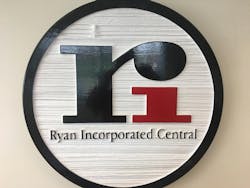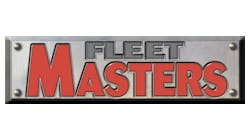“The intention isn’t to blame, but to learn,” says Aaron Mayer, Ryan Inc. Central’s equipment manager, about the company’s comprehensive vendor-review system, key to its winning the 2018 AEMP/Construction Equipment Fleet Masters Award for small fleets (ERV<$100 million).
Ryan Central, based in Janesville, Wis., is an earthmoving/mass excavation contractor working on landfills and commercial and residential earthwork from the East Coast to Nebraska with approximately 500 units in its fleet, including 80 to 100 40-ton ADTs, 20 excavators from 45 tons up to 90 tons, 60 medium-sized dozers, a healthy scraper fleet, and a host of smaller supporting equipment.
Naturally, Ryan Central deals with a wide variety of vendors when it comes to purchasing, leasing, and servicing its iron. Mayer has developed a keen interest in vendor performance and relationships, particularly with the many equipment dealers it works with.
When he joined the company 10 years ago, Mayer brought finance expertise from his work at a real estate investment company, but he lacked heavy-equipment knowledge.
“I went around and met with everyone in the equipment department,” Mayer said. “I asked what their job was, why they do what they do, and is there anything Ryan does really well, or, something that needs improvement? At the same time, I became involved in signing off on repairs and working more closely with dealers. And when there was a machine in the shop, I spent the day there, trying to get up to speed with the repair process.”
As he interacted with dealers, Mayer kept hearing about many of the same issues. “Through that process, you talk about issues you have, and a lot of the vendors have good suggestions, too. In some cases, the issues were the result of us not saying anything. It was just assumed that it couldn’t be changed.”
Mayer was also doing Ryan’s internal employee evaluations at that time. “I remember thinking, ‘We should do this with our vendors.’ It would be a way to create some kind of rubric, solicit feedback from everybody, and present it in some quantitative way.”
Superior Construction was a finalist in the small-fleet category. Read more here.
As a result, Ryan Central’s vendor review process was born. Each year, Mayer sends out a survey to everyone at Ryan who interacts with a vendor; even the accounting department is involved. Everyone is asked to come up with ratings from one to 10.
“We have our own staff of mechanics, but we also use a lot of vendor mechanics,” Mayer says. “For instance, if we have a Cat mechanic who’s working for us all season, he would evaluate the John Deere dealer and the Volvo dealer, because he’s working with all of them to help secure parts and service—he doesn’t only work on Cat equipment. It’s all part of trying to get as much feedback as possible.”
The surveys are divided into two groups made up of several performance categories. The first, more quantitative group is composed of mutually exclusive, stand-alone functional areas such as sales and service. The second, more qualitative group is composed of areas such as dependability, care of equipment, and safety.
“Survey respondents provide the ratings in the categories that would apply to them,” Mayer says. “I also ask that everybody provide a specific example of why, especially if the rating is exceptionally good or bad, because it’s helpful to have examples to talk about. The results are averaged so everyone’s feedback is equally weighted.”
On the subsequent report, not only is the year’s average score for the vendor in each category included, but the anecdotals are also listed (bullet-pointed examples), as are the last three years’ averages. On the final page, a bar graph shows where the vendor stacks up, rating-wise, with other vendors in its category, the vendor average, the maximum score, and the minimum score.
The graphs help adjust for differences in the way respondents rate. “When we first did this, we had a very simple scale—below requirements, meets requirements, exceeds requirements—but it didn’t allow for enough differentiation between vendors,” Mayer says. “So I went to this 10-point scale and explained what I thought was a 10, a 7, a 5.
“I had a hard time getting people to score consistently, so by sharing [the graph], it removes that factor in a way. In other words, even if there are slight differences in respondent methodologies, the graphs give vendors perspective by showing how they fare relative to others,” Mayer says. “It’s a lot better today in terms of consistency than five years ago.”
The overall ratings paint an accurate picture, and the anecdotals, for which Ryan employees keep notes throughout the year, provide some key lessons.
“In 2017, we had a dozer that came in that someone likely vandalized by putting some contaminants in the hydraulic tank,” Mayer says. “But the repair really got out of hand. It went [to the dealer] with us thinking it was a warranty job for a hydraulic pump, that’s what the mechanic in the field troubleshot it as, but as they got into it, they couldn’t figure out exactly what was wrong. They did some testing and they ultimately figured out that it was likely vandalized.
“What was frustrating was that we didn’t know what was going on until we were substantially committed, cost-wise,” Mayer says. “They just kept going and going and going. At the end of the day, the machine was repaired properly, but it would have been nice to know where it was going sooner, because then we could get our insurance company involved early on. So that was a talking point, an example of where the shop service was decent overall, but we did have this communications issue.”
Ryan Central rates between 20 and 30 key vendors each year, and holds meetings with a dozen or so to review the results.
“We present the summaries to them, but we also ask for feedback,” Mayer says. “Is there something we’re doing that we could change that would make your life a lot better, or that would make the business we do more efficient? There are things that come up that we’ve changed; we get a lot of good ideas from vendors, actually.”
It wasn’t always so enthusiastically received.
“When we first started doing this, [vendors] did it because we’re the customer and we’re asking for this,” Mayer explains. “I felt like in at least half the cases, they were kind of unsure of this, uncomfortable. We explain that we’re really interested in a long-term relationship, a partnership, in trying to do business as efficiently as possible, and this is a good way to look back and review the year without the emotions.
“Yes, you could have something negative happen the week before, but this lets us take a broader view and talk about other specific examples,” he says.
Mayer says he looks at the review process not as a stick, but as a tool that facilitates collaboration. “Yes, it’s feedback, it’s a report card, but the underlying assumption is that we value the long-term relationship,” he says. “We’re asking them to improve and if they see something we can improve, to tell us. And they have.”
Ryan Central has used the ratings as part of vendor agreements, the same agreements that lock in rental rates, machine pricing, and labor rates. “I have some set up that reference the vendor-review process, that they need to make a good faith effort to stay above a certain point, and if there’s a downward trend, we’re able to adjust our business with them,” Mayer says.
“It’s certainly increased the depth and breadth of our relationships, because we’ve become very familiar with each others’ processes,” he says.
“I’m the kind of person who is not satisfied until I understand ‘why.’ So I really want to dig into things to change them,” Mayer says. “And this has fostered a collaborative kind of relationship that has created a lot of trust—I think our relationships are certainly better than they were 10 years ago.”








